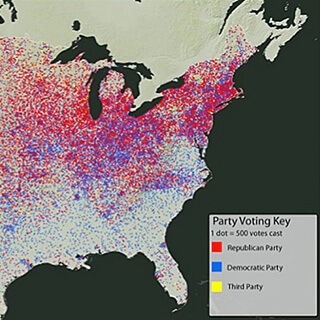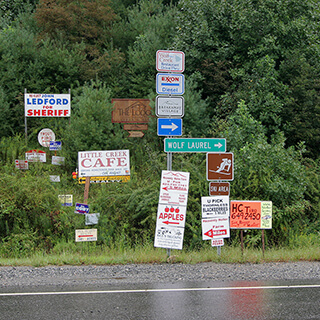Overview
Rob Amberg reviews Driving Through Time: The Digital Blue Ridge Parkway in North Carolina, a website published by Documenting the American South (DocSouth), a program of the University of North Carolina Library System.
 |
| Banner image for Driving Through Time, DocSouth, 2012. |
Review
Well-worn words and phrases come to mind when driving the Blue Ridge Parkway—stunning, dramatic, timeless, a miracle of engineering and landscape architecture—and all of them ring true. Cruising even a short section of the Parkway on a crisp fall afternoon does give a person pause and inspires superlatives we don't often get to use in today's world. But the word that comes to this driver's mind is slow. I feel it immediately as I enter the roadway—not only my car decelerating to the forty-five mph speed limit, but also my breathing slowing to match the surroundings. The Parkway encourages, insists, that motorists adopt slow time, change their pace, and step back; for me, this is the Parkway's real gift to the public.
Slow has served as the operative word since the Parkway's conception as one of Franklin Roosevelt's New Deal programs. Controversial decisions regarding land use, routing, right-of-way, and access to the roadway from local communities delayed the beginning of actual construction until 1935. After a break for World War II, all but 7.5 of the Parkway's 469-miles opened to the public in 1961. Those final few miles, around Grandfather Mountain in North Carolina, the "missing link," took another twenty-six years to complete because of environmental and public relations concerns and lawsuits filed by the mountain's owner and promoter, Hugh Morton.
 |
| Screen capture of the GeoBrowse tool, Driving Through Time, 2012. The GeoBrowse tool allows visitors to browse documents in the collection by geographical location. |
Beyond the political and legal challenges, the actual construction of the Parkway proved difficult at best and tortuous at worst. High mountain terrain, twenty-six tunnels, weather, and an existing landscape that often had to be made "scenic" presented challenging and ongoing obstacles to the engineers, architects, and workers tasked with building the road. But, after fifty-two years of work, and twenty-five years since its completion, the Blue Ridge Parkway continues to resonate in reality and imagination. According to Anne Mitchell Whisnant, author of Super-Scenic Motorway: A Blue Ridge Parkway History, and the scholarly advisor for the website Driving Through Time, "Since 1946, the Blue Ridge Parkway has been the most visited site in the entire national park system. In recent years, more than eighteen million visitors have traveled parts of the Parkway every year."1Anne Mitchell Whisnant, "About the Parkway," Driving Through Time: the Digital Blue Ridge Parkway in North Carolina, accessed March 20, 2012, http://docsouth.unc.edu/blueridgeparkway/about/about_parkway/parkway/.
Driving Through Time: the Digital Blue Ridge Parkway in North Carolina, a construction of materials from numerous sources, has recently been published by Documenting the American South (DocSouth), a program of the University of North Carolina Library System. A coming addition will include the Virginia section.
It's a huge collection. 363 newspaper articles, thirty-one oral histories, 121 letters, 104 maps, thirty-one drawings and plans, and 3,547 photographs will keep the most dogged visitor on site for days. Searchable by date, subject, and location, materials are meticulously cross-referenced and captioned. Driving Through Time also provides "overlooks," a series of essays and exhibits that will grow over time. These brief stopovers illustrate particular fragments of Park history; for example, an illustrated essay by Katy Vance and Amanda Foster adds welcomed texture and nuance to Asheville's relationship with the Parkway.
Driving Through Time organizes materials in space and time. Geo-referenced historic maps align past and present locations through Google Maps. The geo-browse function gives most materials a geographic coordinate. And the website offers suggestions for use in K-12 classrooms.
 |
| Robert E. Howe, #7, Yellowstone Falls and Headwaters of the East Fork of the Pigeon River, Section 2V of the Blue Ridge Parkway, 1955. National Park Service—Blue Ridge Parkway. This image is accessible through the "Explore" feature of Driving Through Time. |
Photographs make up the bulk of Driving Through Time. The Park Service employed numerous photographers over the years and their work provides evidence of the construction process, the existing landscape, and the times. These photographers created a clear and coherent record of the process. It's a utilitarian portrait, but as you slowly view the pictures, you're left with a discernible sense of place and time. The photographs feel familiar—families picnicking or stopped at overlooks, masons laying stone archways, landscapes. I found one image from 1955 of Yellowstone Falls and the headwaters of the Pigeon River eerily reminiscent of a graying photograph from a family vacation. I've often wondered where that picture was made; my parents couldn't remember. But seeing Robert Howe's image from section 2V of the Parkway told me we had probably stopped at that same overlook. Other visitors to this website will have similar revelations.
While the majority of the pictures in Driving Through Time come with captions which provide engaging ancillary information, the newspaper articles, letters, and oral histories immerse visitors in the Project's minutiae. We can read accounts of drawn-out battles between the state and individual landowners over eminent domain and right-of-way or about the political maneuvering and public relations wars orchestrated by Tennessee and North Carolina over the Parkway's route.
 |
| Screen capture of "We Drivers," an Overlooks exhibit, Driving Through Time, 2012. Modeled on the overlooks that punctuate the Blue Ridge Parkway, these short articles highlight documents in the Driving Through Time collection. |
There are gaps. The majority of the Driving Through Time collection comes from the five decades of the Parkway's construction—the 1930s through the 1970s (the 30s, with 1,499 items, has the most representation). In contrast, the decades from 1980 to 2009 have only sixty-eight entries. And, while there is significant documentation of the historical record and the people who shaped that history, we don't get the same detail regarding what I would call the personal past—how the Parkway impacted the 4,500 smaller landowners—the people who lost a couple of acres of high pasture or others who had to move their houses out of the sightline of the road. I also wanted to hear from the driving public—families, church groups, and individuals—to get a feeling of their relationship with the Parkway. But those stories, especially from the early years, likely don't exist except in people's living rooms. A problem? Probably not, although I did find myself thinking a re-photographing and interview project would provide an opportunity for comparison between then and now.
But I'm being picky. Driving Through Time offers an insightful journey—a slow, deliberate meander through our shared history and landscape that lets us see far below the Blue Ridge Parkway's surface. So, pack a lunch, sit down, start up your computer, and take the trip. It's a drive worth taking. 
Recommended Resources
Catlin, David T. A Naturalist's Blue Ridge Parkway. Knoxville, TN: University of Tennessee Press, 1984.
Jolley, Harley E. The Blue Ridge Parkway. Knoxville, TN: University of Tennessee Press, 1969.
Whisnant, Anne Mitchell. Super-Scenic Motorway: A Blue Ridge Parkway History. Chapel Hill: University of North Carolina Press, 2006.
Links
Blue Ridge Parkway Foundation
http://www.brpfoundation.org/.
Documenting the American South
http://docsouth.unc.edu/.
Similar Publications
| 1. | Anne Mitchell Whisnant, "About the Parkway," Driving Through Time: the Digital Blue Ridge Parkway in North Carolina, accessed March 20, 2012, http://docsouth.unc.edu/blueridgeparkway/about/about_parkway/parkway/. |
|---|

